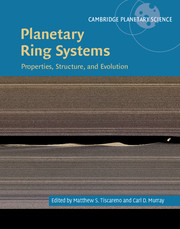Book contents
- Frontmatter
- Contents
- List of Contributors
- Acknowledgements
- I Introductory Material
- II Ring Systems by Location
- III Ring Systems by Type and Topic
- 8 Moonlets in Dense Planetary Rings
- 9 Meteoroid Bombardment and Ballistic Transport in Planetary Rings
- 10 Theory of Narrow Rings and Sharp Edges
- 11 Narrow Rings, Gaps, and Sharp Edges
- 12 Dusty Rings
- 13 The F Ring of Saturn
- 14 Plasma, Neutral Atmosphere, and Energetic Radiation Environments of Planetary Rings
- 15 Thermal Properties of Rings and Ring Particles
- 16 Computer Simulations of Planetary Rings
- 17 Laboratory Studies of Planetary Ring Systems
- 18 The Origin of Planetary Ring Systems
- IV Concluding Material
- Index
- Plate section
- References
8 - Moonlets in Dense Planetary Rings
from III - Ring Systems by Type and Topic
Published online by Cambridge University Press: 26 February 2018
- Frontmatter
- Contents
- List of Contributors
- Acknowledgements
- I Introductory Material
- II Ring Systems by Location
- III Ring Systems by Type and Topic
- 8 Moonlets in Dense Planetary Rings
- 9 Meteoroid Bombardment and Ballistic Transport in Planetary Rings
- 10 Theory of Narrow Rings and Sharp Edges
- 11 Narrow Rings, Gaps, and Sharp Edges
- 12 Dusty Rings
- 13 The F Ring of Saturn
- 14 Plasma, Neutral Atmosphere, and Energetic Radiation Environments of Planetary Rings
- 15 Thermal Properties of Rings and Ring Particles
- 16 Computer Simulations of Planetary Rings
- 17 Laboratory Studies of Planetary Ring Systems
- 18 The Origin of Planetary Ring Systems
- IV Concluding Material
- Index
- Plate section
- References
Summary
INTRODUCTION
When, in 1610, Galileo Galilei directed his telescope at Saturn, he discovered some puzzling addenda on either side of that planet, changing their appearance over the course of a few years – and even more disturbing, at certain instants they seemed to disappear and then return. These appendages remained a scientific riddle for about half a century until Christian Huygens came up with a seemingly correct model – he proposed that a solid ring is girdling Saturn. In 1675, G. D. Cassini's detection of a division in Saturn's rings – the Cassini Division separating the outer A and inner B rings – questioned Huygens’ hypothesis of a solid ring.
Almost 200 years later, in his famous work, Maxwell (1859) proved that a solid ring cannot be a stable configuration, suggesting instead that a myriad of individual tiny satellites form the rings of Saturn. This theoretical prediction was later confirmed experimentally by J. E. Keeler, who measured Doppler frequency shifts on either side of Saturn's rings (Keeler, 1889, 1895), showing that individual ring particles encircle Saturn at Kepler speeds.
Since those studies in the nineteenth century, the mesoscopic particulate nature of Saturn's rings has been widely accepted. Since the prediction of a flat monolayer ring by Jeffreys (1947), mainly suggested by the frequent inelastic collisions among the ring particles, only a little has been said about the properties of ring particles themselves – their size distribution, composition, etc., and their evolution as a granular ensemble.
Hénon (1981), motivated by the Pioneer and Voyager space missions to the outer solar system in the late 1970s and early 1980s, assumed a broad size distribution of the ring particles in order to explain spacecraft observations of the dense rings of Saturn. Properties like the apparent thickness of the rings or the distribution of the widths of dilute or empty gaps have been addressed by an extended power-law to characterize the size distribution of the ring particles. The idea behind this approach is that, depending on its size, a ring particle (especially sub-kilometer or kilometer-sized boulders, hereafter called moonlets) should gravitationally carve density features in the surrounding ring matter.
- Type
- Chapter
- Information
- Planetary Ring SystemsProperties, Structure, and Evolution, pp. 157 - 197Publisher: Cambridge University PressPrint publication year: 2018
References
- 2
- Cited by



